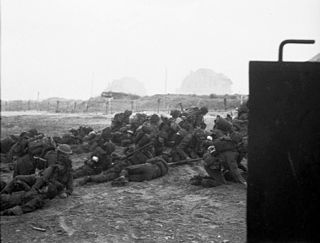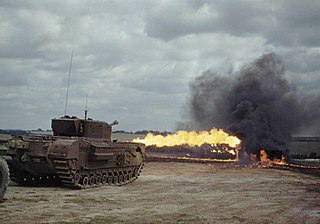
Sword, commonly known as Sword Beach, was the code name given to one of the five main landing areas along the Normandy coast during the initial assault phase, Operation Neptune, of Operation Overlord. The Allied invasion of German-occupied France commenced on 6 June 1944. Stretching 8 kilometres (5.0 mi) from Ouistreham to Saint-Aubin-sur-Mer, the beach proved to be the easternmost landing site of the invasion after the abortion of an attack on a sixth beach, code-named Band. Taking Sword was to be the responsibility of the British Army with sea transport, mine sweeping and a naval bombardment force provided by the British Royal Navy as well as elements from the Polish, Norwegian and other Allied navies.

The Guards Armoured Division was an armoured division of the British Army during the Second World War. The division was created in the United Kingdom on 17 June 1941 during the Second World War from elements of the Guards units, the Grenadier Guards, Coldstream Guards, Scots Guards, Irish Guards, Welsh Guards, and the Household Cavalry.

The 3rd Division is a regular army division of the British Army. It was created in 1809 by Arthur Wellesley, 1st Duke of Wellington, as part of the Anglo-Portuguese Army, for service in the Peninsular War, and was known as the Fighting 3rd under Sir Thomas Picton during the Napoleonic Wars. The division fought at the Battle of Waterloo, as well as during the Crimean War and the Second Boer War. As a result of bitter fighting in 1916, during the First World War, the division became referred to as the 3rd (Iron) Division, or the Iron Division or Ironsides. During the Second World War, the division fought in the Battle of France including a rearguard action during the Dunkirk Evacuation, and played a prominent role in the D-Day landings of 6 June 1944. The division was to have been part of a proposed Commonwealth Corps, formed for a planned invasion of Japan in 1945–46, and later served in the British Mandate of Palestine. During the Second World War, the insignia became the "pattern of three" — a black triangle trisected by an inverted red triangle, created by Bernard Montgomery to instil pride in his troops.

Hobart's Funnies is the nickname given to a number of specialist armoured fighting vehicles derived from tanks operated during the Second World War by units of the 79th Armoured Division of the British Army or by specialists from the Royal Engineers.

The 79th Armoured Division was a specialist armoured division of the British Army created during the Second World War. The division was created as part of the preparations for the Normandy invasion on 6 June 1944, D-Day.

The Westminster Dragoons (WDs) was a yeomanry regiment of the British Army Army Reserve, located in central London. Its lineage is continued by one of the Royal Yeomanry's six squadrons. Formed in the aftermath of Second Boer War as part of the County of London Yeomanry, the WDs fought in the Battle of Gallipoli and led British forces onto the beaches during the Normandy Invasion in 1944. The squadron most recently saw action on Operation Telic for which it was mobilised for the 2003 war in Iraq.

The 43rd (Wessex) Infantry Division was an infantry division of Britain's Territorial Army (TA). The division was first formed in 1908, as the Wessex Division. During the First World War, it was broken-up and never served as a complete formation. It was reformed in the TA in 1920, and then served in the campaign in North West Europe from June 1944 until May 1945, during the Second World War. The division suffered heavy casualties and gained an excellent reputation. After the Second World War, the division formed part of the postwar TA, and became the 43rd (Wessex) Division/District in 1961. It was finally disbanded in 1967.

The 22nd Dragoons was the title held by five separate Cavalry regiments of the British Army raised and disbanded between 1716 and 1945. The last regiment of this name existed during the Second World War, from 1 December 1940 until 30 November 1945.
The 43rd Royal Tank Regiment was an armoured regiment of the British Army's Royal Armoured Corps that tested and demonstrated specialised Armoured Fighting Vehicles during World War II.
The 51st Royal Tank Regiment was an armoured regiment of the British Territorial Army that fought in the Tunisian and Italian campaigns during World War II and continued to serve during the 1950s.
49th Royal Tank Regiment, later 49th Armoured Personnel Carrier Regiment and 49th Armoured Carrier Regiment, was a regiment of the British Army's Royal Armoured Corps during World War II that operated specialised armoured fighting vehicles in North West Europe.

The 27th Armoured Brigade was an armoured brigade of the British Army that served in the Second World War and played a crucial role in the Normandy landings on 6 June 1944 and the following Battle of Normandy until disbandment in late 1944.

The Churchill Crocodile was a British flame-throwing tank of late Second World War. It was a variant of the Tank, Infantry, Mk IV (A22) Churchill Mark VII, although the Churchill Mark IV was initially chosen to be the base vehicle.

Armoured Vehicle Royal Engineers (AVRE), also known as Assault Vehicle Royal Engineers is the title given to a series of armoured military engineering vehicles operated by the Royal Engineers (RE) for the purpose of protecting engineers during frontline battlefield operations.

The 6th Guards Tank Brigade was an armoured brigade of the British Army during the Second World War formed from the Foot Guards in 1941 as the 6th Guards Armoured Brigade when the United Kingdom was under the threat of invasion and more armoured formations were required.

Operation Astonia was the codename for an Allied attack on the German-held Channel port of Le Havre in France, during the Second World War. The city had been declared a Festung (fortress) by Hitler, to be held to the last man. Fought from 10 to 12 September 1944, the Allied objective was to secure the harbour facilities intact, to deliver supplies to the Allied armies in Continental Europe. The Allies refused to let the civilian population be evacuated, despite offers of free passage by the fortress commander.

The 144th Regiment Royal Armoured Corps was an armoured regiment of the British Army. Originally raised during World War II as a battalion of the East Lancashire Regiment it was later transferred to the Royal Armoured Corps. It fought in the campaign in North-West Europe, from June 1944 to May 1945.
The 107th Regiment Royal Armoured Corps (King's Own) (107 RAC) was a tank regiment of the Royal Armoured Corps, raised by the British Army during the Second World War. The regiment served with distinction in North-west Europe from July 1944 to May 1945.

The 34th Armoured Brigade was an armoured brigade of the British Army that saw active service in the Second World War. It was formed in 1941 as the 34th Army Tank Brigade and subsequently redesignated as the 34th Tank Brigade in February 1945 and became part of the 79th Armoured Division. It was equipped with Churchill tanks and provided close support for assaults by the infantry. During the fighting in North-west Europe from July 1944 to May 1945 the brigade served with both the First Canadian Army and the British Second Army. The brigade was disbanded in early 1946.
The 11th Royal Tank Regiment was an armoured regiment of the British Army. It is part of the Royal Tank Regiment, itself part of the Royal Armoured Corps.


















